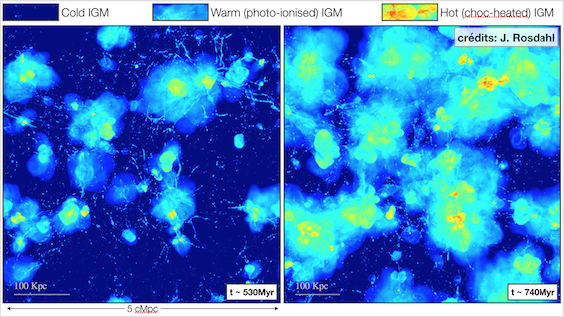Simulating the epoch of reionization on Europe’s most advanced computers
The epoch of reionisation (EoR) is one of the most fascinating chapters in the history of the Universe. It begins a few hundred million years after the Big Bang, when the first stars form and light up, bringing an end to the so-called Dark Ages. As structures grow, these first stars become the first generations of galaxies, which soon emit enough ultraviolet radiation to ionise and heat up all the intergalactic gas. Although observations tell us unambiguously that the full Universe was reionised about 1 billion years after the Big Bang, theoreticians still struggle to provide a fully consistent explanation of this process. The major difficulty in this field comes from the range of scales involved. Ionising radiation is produced by massive stars deep inside galaxies, and its ability to escape out of galaxies to ionise the Universe is determined by the distribution of dense gas in their very nearby environment at scales of a few tenths of light-years. Once radiation escapes, however, it is able to travel through mostly empty intergalactic space, covering millions of light-years. Until recently, there did not exist any numerical method which could cope with these two extreme regimes in a consistent way, and researchers either simulated individual galaxies with great detail or large volumes of the Universe in which they hardly resolved galaxies.
Recently, Joakim Rosdahl (Centre de Recherche Astrophysique de Lyon) and H. Katz (Cambridge University) have developed a brand new numerical scheme which solves this problem and represents a major breakthrough in the field. Their scheme allows the propagation of light in cosmological simulations at all scales from the dense inter-stellar medium, where ionisation bubbles expand slowly due to the dense gas, to the extreme voids of the intergalactic medium, where they expand close to the full speed of light. On the Common Computing Facility (CCF) of the LabEx LIO, they tested their method extensively and ran pilot simulations which demonstrate its success. J. Rosdahl then assembled and led a team of world-wide experts from CRAL, Cambridge Univ., Strasbourg Univ., and Zurich Univ., to put out a Partnership For Advanced Computing In Europe (PRACE, call 14) application for computing time on Europe’s most advanced computers. Their application turned out to be the only successful application in astrophysics led by a French institute and they obtained 13,7 million hours of computing time on the SuperMUC computer (Germany) to carry out a full-scale numerical experiment. The simulations will take a few months (man-time) to run on 10,000 parallel computing cores, and the first scientific results will be submitted for publication in late 2017. Among many questions which will be addressed with this project are which galaxies dominated the process of reionisation (high-mass vs low-mass, heavily star-forming vs relatively quiet), how do subtly different models for ultraviolet emission from stars on very small scales affect the reionisation process, and how did reionisation inhibits further galaxy formation.
View online : See the movie from which the image above is extracted









